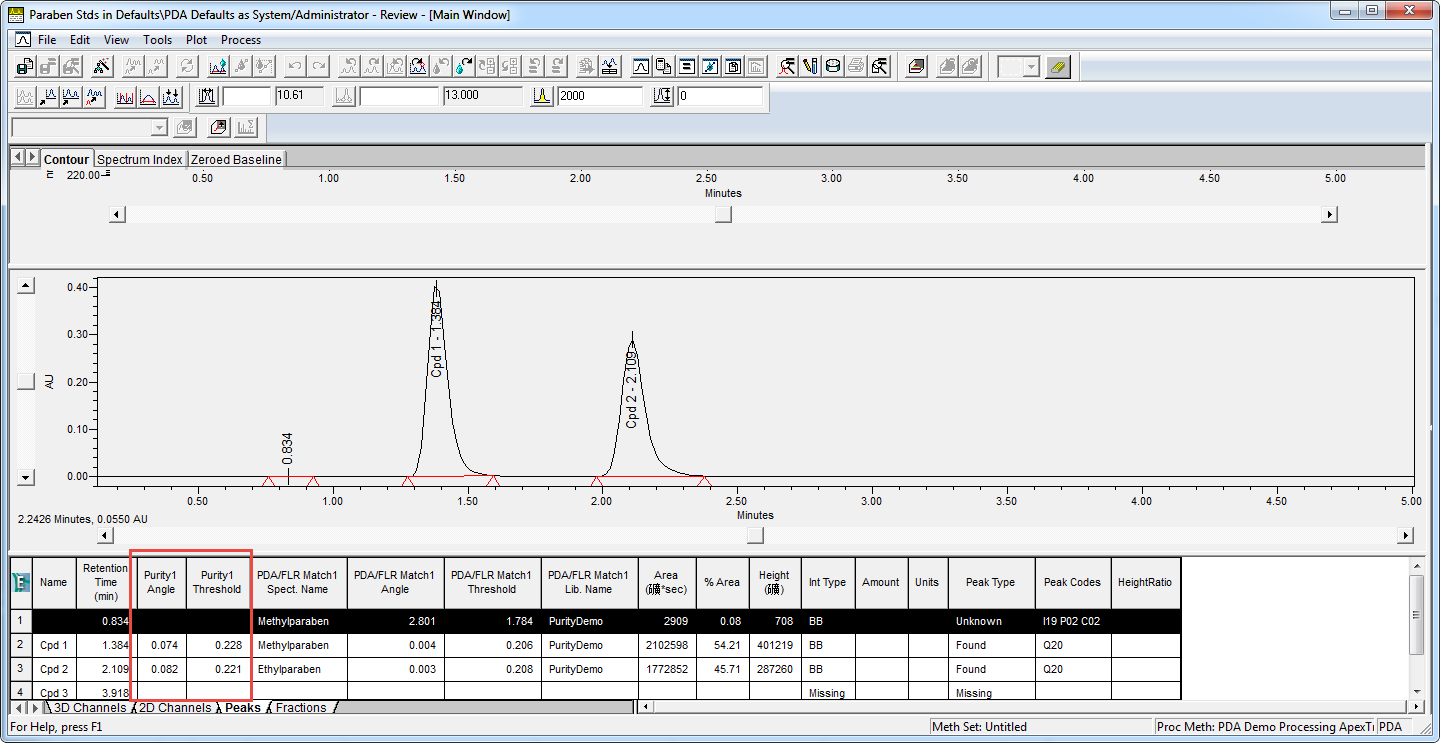Empower 3 PDA: What is Purity 1 Angle, Purity 1 Threshold (How is the peak purity determined)? - WKB85832
ENVIRONMENT
- Empower 3
- Empower 2
- Empower
- Project with the PDA option ON
ANSWER
★ What is the purity test?
In the purity test, the waveform of the spectrum at the peak top and the waveform of all the spectra in the peak are corrected and the shapes are compared.
If the shape of the spectrum is different in the middle of the peak, firstly it should be considered that other components with different spectral waveforms co-elute with the peak.
This is how the determine purity is determined.
★Purity of the entire peak
The purity of the entire peak is determined by the purity angle and the threshold angle.
Purity angle: The average value of the angle between each spectrum of the peak and the spectrum at the top of the peak. In other words, the purity of the entire peak can be determined by this value.
・ If <0.2
The detection limit of this method is about 0.1 to 0.2. Therefore, it can be concluded that the peak for which the purity values below 0.2 consists of almost the same spectral components.
The measurement precision of this is better than the visual check (up to 1 angle).
・If > 1
Although there are differences in shape that can be observed by the visual check, the purity angle alone does not mean that components with other spectra have co-eluted.
This is because other than the co-elution of other components, the noise included in the spectra can also cause the differences. This should be noted especially with low-concentration components.
Threshold angle: An index value indicating the effect of the noise (evaluated by S/N ratio) over the entire peak. Thisi is evaluated by comparing the values of the purity angles.
・If purity angle < purity threshold angle
Even when the purity angle is large, it can be determined that there is no obvious co-elution within the range of the threshold angle that indicates the effect of the noise.
・If purity angle > purity threshold angle
If the purity angle is larger than the threshold angle indicating the shape differences of the spectra caused by noise, there is a spectra difference exceeding the effect of noise.
It is highly likely that components with different spectra are co-eluting.

CONSIDERATIONS
1. The values of purity angle and purity threshold are large
In the case of "purity angle < purity threshold angle", there is no obvious co-elution. For example, when purity angle = 9.5, threshold angle = 10.0
Since the purity angle is smaller than the threshold angle by 0.5, it can be determined that there is no obvious co-elution, but in some cases, spectrum components with small differences of less than 10.0 angle could have been co-eluted.
Angle of 10 means that the difference between the standardized spectra is about 10%, and that the spectra components for which the difference is less than about 10 can not be found.
2. Low specificity of UV/Vis spectrum
Empower3PDA determines the difference between the spectra and does not directly detect chemical components. In particular, the waveform of the UV/Vis spectrum is determined by the basic skeleton of the chemical structure, and it does not change due to the terminal alkyl group.
In other words, there are many components which have the same waveform, and they may not be found with Empower3PDA.
3. Amount of the co-eluting components
Even if the amounts of co-eluting components are the same, the purity angle value greatly changes depending on the difference between the spectra of the peak main component and co-eluting components.
If the co-eluting components can’t be identified, the amount of co-eluting components cannot be evaluated from the purity angle.
4. Poor purity of the standard
High purity standard samples can be determined to be of poor purity mainly for the following reasons.
・The concentration is too high
Even if the absorbance exceeds 1 AU only at partial wavelengths, the absorbance linearity will be lost and the spectrum will be distorted, and the purity is measured to be poor. Please reduce the concentration so that the absorbance at the maximum absorption does not exceed 1 AU, and perform the measurement again.
・High background absorption of the mobile phase
If the background absorption of the mobile phase is large at low wavelengths, the linearity range of the absorbance at that wavelength becomes small and the measured spectrum will be distorted. In this case, narrow down the wavelength range to be calculated on the Purity tab of the processing method and reprocess. Or avoid the wavelengths with large background absorption and remeasure.
5. Components with significantly different spectra should be eluted at the same time.
The primary reason that co-elution cannot be found is that similar spectra have co-eluted with a small amount, but it could happen that they cannot be detected even if the spectra differ significantly.
That is when the co-eluting component uniformly overlaps the peak.
In this case, the components that co-elute with the same ratio are overlapped at both the peak base and the peak apex, which is used as the determination standard. Briefly, the waveform of each spectrum is the same as the sum of the two waveforms with the same ratio.
This cannot be detected by the purity test.
In this case, confirm whether or not the peak apex waveform differs from the spectrum of the standard to determine the presence or absence of co-elution. This can be performed by library searching.
ADDITIONAL INFORMATION
Is there a document that discusses Empower peak purity? - WKB46540
id85832, A-30PDA, eluent, EMP2LIC, EMP2OPT, EMP2SW, EMP3GC, EMP3LIC, EMP3OPT, EMP3SW, EMPGC, EMPGPC, EMPLIC, EMPOWER2, EMPOWER3, EMPSW, SUP, UPAPDA, UPARPPDA, UPC2PDA, UPPDA, UPPDAARC, UPPDAARCB, UPPDA-E, UPPDA-L, UPPDALTC, UPPDATC, UPPPDA

